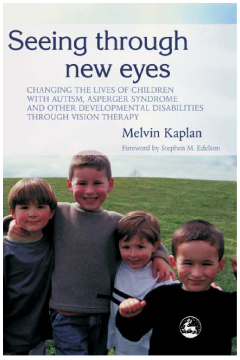
Additional Information
Book Details
Abstract
Seeing Through New Eyes offers an accessible introduction to the treatment of visual dysfunction, a significant but neglected problem associated with autism spectrum disorders (ASDs) and other developmental disabilities.
Dr. Kaplan identifies common ASD symptoms such as hand-flapping, poor eye contact and tantrums as typical responses to the confusion caused by vision disorder. He also explains the effects of difficulties that people with autism experience with "ambient vision", including a lack of spatial awareness and trouble with coordination. Other chapters give guidance on how to identify the visual deficits of nonverbal children, select prism lenses that will alter the visual field, and create individually tailored programs of therapy in order to retrain the system.
This book is essential reading for parents of children with ASDs, and professionals in the fields of autism, optometry and ophthalmology, psychology and education.
I've been amazed at how the yoked prism lenses Dr. Kaplan uses can have an immediate impact on a child's behavior. These instant changes can translate, with the help of vision therapy, into long-term changes including better attention, increased speech, enhanced social skills, and better academic performance. They also can result in a happier, less anxious, less tense individual, with more energy to understand and enjoy the world.
From the Foreword by Stephen M. Edelson, Autism Research Institute, San Diego, CA
Kaplan, an optometrist and Director of the center for visual management, believes visual dysfunction to be a significant but neglected problem associated with autism spectrum disorders (ASDs) and other developmental disabilities. He points to some of the behaviours associated with ASD, such as poor eye contact as proof, and promotes identifying and diagnosing visual defects in children so professionals can determine appropriate therapies such as prism lenses.
Book News
This book is a must read for any doctor who wishes to treat and/or perform VT on those with autism or developmental disabilities. It is well organized and has a logical flow. If you chose to incorporate individuals on the autism spectrum in your practice, this book will be a good resource.
Journal of Behavioural Optometry, 2007
Melvin Kaplan OD is Director of the Center for Visual Management in New York. He is a qualified Doctor of Optometry, and has previously worked as a clinical instructor of behavioral sciences at New York Medical College. He has published a significant body of research on ambient lenses and their role in the rehabilitation of individuals who display dysfunction in learning or emotion, and those with autistic spectrum disorders.
Kaplan, an optometrist (eye/vision specialist) with extensive experience of working with individuals with development disabilities, shares his enthusiasm and attempts to explain the theory behind his work.
Community Care
